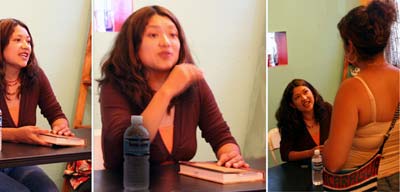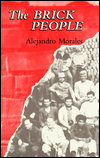As noted last week, I’d receive
d several e-mails with some very sad news: Professor Guillermo Hernández had died suddenly in Mexico City while serving as the program director/instructor for UCLA’s travel study program based in Puebla. I was planning on putting together a remembrance of Prof. Hernández but this Saturday, the Los Angeles Times published a well-written obituary by Valerie J. Nelson that was better than anything I could have composed. Accordingly, I decided that I’d simply reprint the piece in its entirety. Please note the last paragraph regarding the family’s suggested donations to the Guillermo E. Hernández Memorial Scholarship Fund. --
DAOGuillermo Hernandez, 66; Expert on the Corrido, a Mexican Ballad Tradition
By Valerie J. Nelson
Times Staff Writer
July 22, 2006
Guillermo Hernandez, a leading authority on the corrido — a Mexican ballad tradition that dates back more than two centuries — and an expert on Chicano literature who helped establish an expansive collection of Mexican and Mexican American music recordings at UCLA, has died. He was 66.
Hernandez, a UCLA Spanish professor, was found dead of a heart attack Sunday in his Mexico City hotel room, his family said. He was on a field trip while leading a UCLA summer program in Puebla, Mexico.
"He was one of the main motivators of current research in Mexican American popular culture, especially the corridos," said James Nicolopulos, a corrido expert and Spanish professor at the University of Texas at Austin. "He's irreplaceable, and I don't know what we are going to do without him."
While director of UCLA's Chicano Studies Research Center, Hernandez played a pivotal role in establishing the Arhoolie Foundation's Strachwitz Frontera Collection. The digital archive of more than 30,000 recordings is one of the most diverse collections of Mexican and Mexican American music at any university. (The archive can be accessed at digital.library.ucla.edu/frontera.)
The project is funded primarily by the Los Tigres del Norte Fund at UCLA, named for the band from San Jose that corrido scholars consider the Rolling Stones of norteño music. Los Tigres, along with its record label, Fonovisa, established the fund in 2000 to promote the study of corridos — working-class music often dismissed on both sides of the border.
"Certainly no one else could have talked a group like Los Tigres — the biggest thing there is in Mexican regional music — into granting a half-million dollars to a project like this," Nicolopulos said.
When he was a student at UC Berkeley, Hernandez's passion for the corrido was ignited while he was consulting on "Chulas Fronteras," a 1976 documentary about music on the Texas-Mexico border. One of the filmmakers was Chris Strachwitz, owner of the folk-music label Arhoolie Records and keeper of an immense collection of commercially recorded Mexican and Tex-Mex music.
The record producer invited Hernandez into his archives, which hold more than 100,000 individual performances spanning almost 100 years. The collection covers many styles, including the corrido, which began as an oral tradition that continues today in Mexican villages. Frequently in waltz time, the songs often chronicle events with pathos and satire, accompanied by accordions and 12-string bass guitars.
Hernandez "became totally fascinated that this material was being recorded so long ago," Strachwitz said. "And he became a champion for the literature of the poor people who are generally not represented in academia, because they don't write books or dissertations; they just make up these incredible songs."
To document the corrido, Hernandez went where his colleagues often would not, into cantinas and dance halls in rough neighborhoods in Mexico. With his natural warmth, he would convince wary balladeers puzzled by an academic's interest that he was just a regular guy, colleagues said.
Recently, Hernandez published an article in the Chicano studies journal Aztlan that documented his decades-long search for the author of a classic and widely imitated 1928 recording, "El Contrabando de El Paso" (The El Paso Contraband). The prisoner's lament is important to the history of the corrido, because so many artists learned the form from it.
Relying on old prison records, Hernandez was able to solve "one of the great mysteries of the corrido," Nicolopulos said, and identify the accidental lyricist: Gabriel Jara, a smuggler caught with 90 gallons of homemade liquor who shared his tale via U.S. mail with a singer on the outside.
Among Hernandez's written works was a 180-page pamphlet that accompanied "The Mexican Revolution: Corridos," a four-record set put out by Arhoolie Records. His translations and transcriptions of the songs were "magnificent," Nicolopulos said.
Hernandez's 1991 book, "Chicano Satire: A Study in Literary Culture," also was important because it traced the genre back hundreds of years, said Chon Noriega, who followed Hernandez as director of the Chicano Studies Research Center. Hernandez ran the center from 1992 to 2003.
In the early 1990s, Hernandez began holding international conferences on the corrido and often conducted seminars. One in Monterrey, Mexico, had a lasting impact after Hernandez taught his audience, primarily amateur enthusiasts, how to do fieldwork on the lyrical narrative.
"These people went back to their hometowns … and produced an immense body of information. It's just been a gold mine, and once again, Guillermo was the sparkplug for that," Nicolopulos said.
In 1998, Hernandez curated one of the first museum exhibits on the corrido, and the Smithsonian Institution sent it on a 10-city national tour.
Born Feb. 28, 1940, in San Luis Potosi, Mexico, Hernandez was one of six children. He grew up with "a love of the whole country," because the family moved around Mexico for his father's job as an educator, said Yolanda Zepeda, whom Hernandez married nearly three decades ago.
Hernandez earned three degrees in comparative literature at UC Berkeley, including a doctorate in 1982 with an emphasis in Spanish medieval literature, and joined the UCLA faculty.
He had a reputation as a caring mentor who liked to joke, cite proverbs and speak in metaphors.
"He was always bringing comedy into the conversation," said Felicitas Ibarra, a graduate student. "We all thought that his classes were full of joy and excitement, and the three hours flew by."
In addition to his wife, Yolanda, of Santa Monica, Hernandez is survived by Arturo, his son from his first marriage, which ended in divorce; three other sons, Luciano, Guillermo and Gabriel; two sisters; two brothers; and three grandchildren.
A memorial service will be held at 9:30 a.m. today at Holy Cross Mortuary, 5835 W. Slauson Ave., Culver City.
Instead of flowers, the family requests that donations be made to the Guillermo E. Hernandez Memorial Scholarship Fund, UCLA, 1309 Murphy Hall, Los Angeles, CA 90095.
* * *
Here are several news items that I’d like to pass along. Also, the new issue of Tu Ciudad is now out and I hope to do a separate post on that very soon.◙ Helena Maria Viramontes will be the recipient of the fourth annual Luis Leal Literary Award this September 30, at the Santa Barbara Public Library, at 4:00 p.m. More on this wonderful news later.
◙ In the El Paso Times,
Rigoberto González reviews Call Me Henri (Curbstone Press) by Lorraine López. He says that it “is a well-constructed novel that speaks eloquently about youth and the immigrant experience. It beautifully captures the struggles of an adolescent male plagued with multiple crises brought on by family and community.” Also in the EPT, book review editor Ramón Rentería
profiles author Rubén Sálaz Márquez.
◙ Marta Acosta, author of the hilarious new novel,
Happy Hour at Casa Dracula (Pocket Books), offers her views regarding Chica Lit in a
letter to The Boston Globe. Her letter begins: “I read with interest your column on teaching ``Like Water for Chocolate" by Laura Esquivel to students (``Like water for the soul," Globe NorthWest, June 18). I think your concern about a ``pandemic" of chica lit may be unwarranted. There are only a few contemporary fiction writers who happen to be Latinas. You could count them on your hands, or your feet -- I don't want to be appendage-ist.”
◙ There is a nice
profile of Cordelia Chávez Candelaria in the online version of the Arizona Republic, azcentral.com. She recently assumed the position of vice provost for academic affairs at Arizona State University’s new Downtown Phoenix campus.
--
Daniel Olivas










